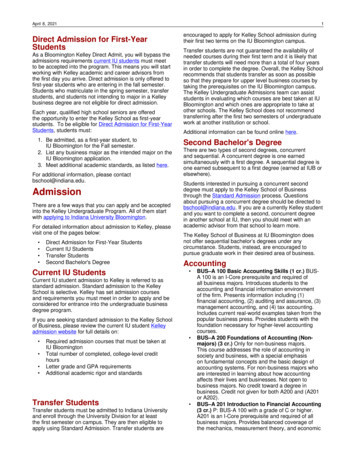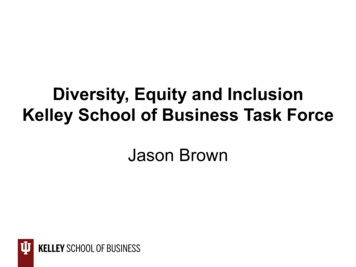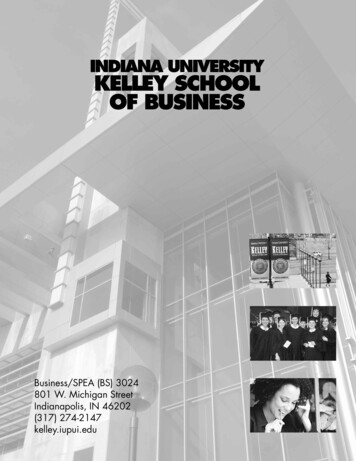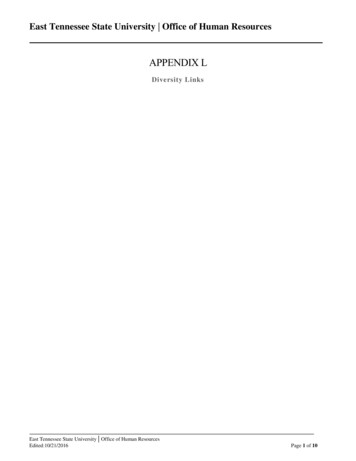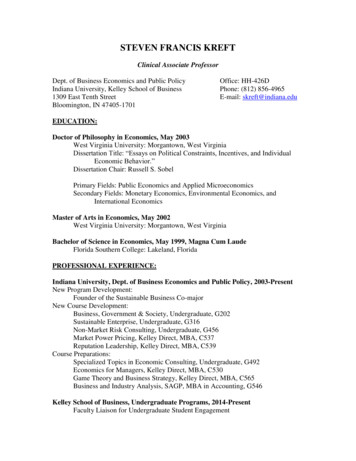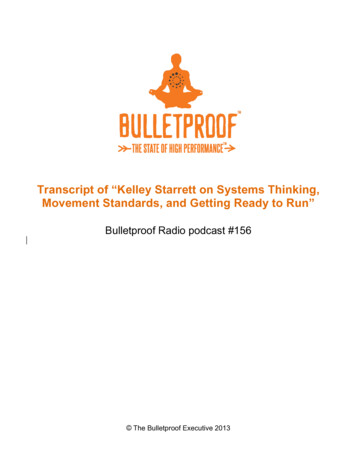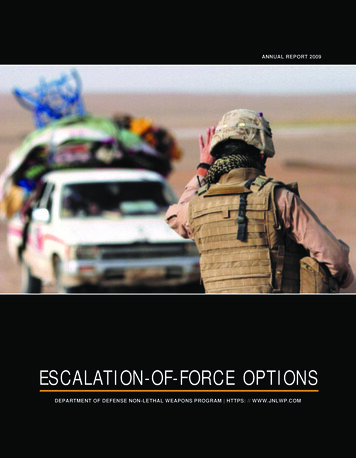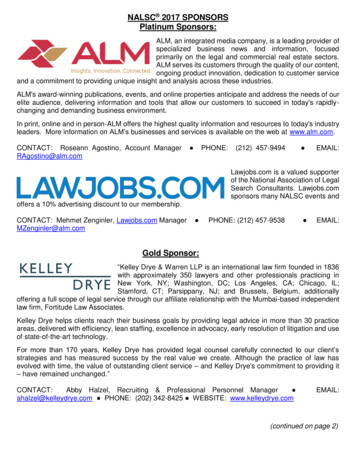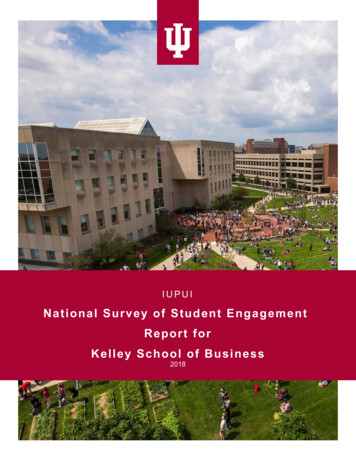
Transcription
IUPUINational Survey of Student EngagementReport forKelley School of Business20181 Entering Student Survey Institutional Researchand Decision Support
2018 NSSE Report for Kelley School of BusinessWelcome to the 2018 Kelley School of BusinessNSSE ReportIUPUI’s VisionTo be a leading urbanresearch institutionrecognized for the success ofits students, its advances inhealth and life sciences, andits intellectual, economic, andcultural contributions to thewell‐being of the citizens ofIndianapolis, the state ofIndiana, and beyond.The National Survey of Student Engagement (NSSE) was developed todocument dimensions of quality in undergraduate education and providesinformation and assistance to colleges, universities, and other organizations toimprove student learning. The final NSSE report consists of 12 scales, referredto as Engagement Indicators. These Engagement Indicators are grouped intofour over-arching themes: Academic Challenge, Learning with Peers,Experiences with Faculty, and Campus Environment. In addition, NSSE alsoasks students about their engagement in High Impact Practices (HIPs) and theamount of time they spend engaged in various activities.The following report is a summary of responses from the Kelley School ofBusiness compared to students enrolled in similar programs at other institutionsthat participated in NSSE. This report uses effect size to quantify differencesbetween your school and peer means. Effect size is a measure of the magnitudeof the difference between two means. Effect size differences for the NSSEEngagement Indicators can be interpreted at the number of standard deviationsbetween the mean for your school and the mean for students majoring in similarprograms at IUPUI peer institutions. Items are labeled as “Areas of Strength” (aneffect size of 0.21 standard deviations greater than the benchmark programsaverage), “Asset to Protect” (between 0.05 and 0.2 standard deviations), “Issueto be Mindful of” (between -0.05 and -0.2 standard deviations below), and“Opportunity for Improvement” (-0.21 or more below the mean). A total of 42 Firstyear and 92 Senior students in the Kelley School of Business had completed thesurvey.1 NSSE Kelley School of Business Report Institutional Research and Decision Support
2018 NSSE Report for Kelley School of BusinessKey Highlights Overall Forty-three percent of Senior respondents plan to work more than 20 hours working for pay off campus and 24%of First Year respondents plan to spend more than 20 hours a week preparing for class. Kelley Seniors completed all high impact practices more than their peers, with 43% more completing servicelearning and 25% more completed culminating senior experiences. There is a large significant difference between Kelley and Peer group First Years, with Kelley students scoringhigher on average, in Effective Teaching Practices. Thirty-nine percent more Kelley School of Business First Year respondents had completed service-learningcompared to Peers.The table below displays the NSSE Engagement Indicators that are considered “Areas of Strength” and“Opportunities for Improvement” for the Kelley School of Business. For more information about the NSSEEngagement Indicators or the NSSE in general, please seehttp://nsse.indiana.edu/html/engagement indicators.cfm.Areas of Strength and Opportunities for ImprovementSeniorsFirst YearAreas of StrengthHigher-Order LearningQuantitative ReasoningCollaborative LearningDiscussions with Diverse OthersQuality of InteractionsHigher Order LearningReflective and Integrative LearningLearning StrategiesCollaborative LearningDiscussions with Diverse OthersStudent-Faculty InteractionEffective teaching PracticesQuality of InteractionsOpportunities for ImprovementReflective and Integrative LearningLearning StrategiesStudent-Faculty InteractionQuantitative ReasoningSupportive Environment2 NSSE Kelley School of Business Report Institutional Research and Decision Support
2018 NSSE Report for Kelley School of BusinessTable 1Academic ChallengeSeniorHigher-Order Learning a1Applying facts, theories, or methods to practicalproblems or new situationsAnalyzing an idea, experience, or line of reasoning indepth by examining its partsEvaluating a point of view, decision, or informationsourceForming a new idea or understanding from variouspieces of informationReflective & Integrative Learning b4Combined ideas from different courses whencompleting assignmentsConnected your learning to societal problems or issuesIncluded diverse perspectives (political, religious,racial/ethnic, gender, etc.) in course discussions orassignmentsExamined the strengths and weaknesses of your ownviews on a topic or issueTried to better understand someone else’s views byimagining how an issue looks from his or herperspectiveLearned something that changed the way youunderstand an issue or conceptConnected ideas from your courses to your priorexperiences and knowledgeLearning Strategies b4Identified key information from reading assignmentsReviewed your notes after classSummarized what you learned in class or from coursematerialsQuantitative Reasoning b1Reached conclusions based on your own analysis ofnumerical information (numbers, graphs, statistics,etc.)Used numerical information to examine a real-worldproblem or issue (unemployment, climate change,public health, etc.)Evaluated what others have concluded form 50.59a 1 VeryLittle, 2 Some, 3 Quite a bit, 4 Very much2 Sometimes, 3 Often, 4 Very Often1 Area of Strength 2 Asset to Protect 3 Issue to be Mindful of 4 Opportunity for Improvementb 1 Never,3 NSSE Kelley School of Business Report Institutional Research and Decision Support
2018 NSSE Report for Kelley School of BusinessTable 2Learning with PeersSeniorCollaborative Learning a1Asked another student to help you understand coursematerialExplained course material to one or more studentsPrepared for exams by discussing or working throughcourse material with other studentsWorked with other students on course projects orassignmentsDiscussions with Diverse Others a1People from a race or ethnicity other than your ownPeople from an economic background other than yourownPeople with religious beliefs other than your ownPeople with political views other than your 60.880.883.13.1EffectSize0.430.33a 1 Never,1 Area2 Sometimes, 3 Often, 4 Very Oftenof Strength 2 Asset to Protect 3 Issue to be Mindful of 4 Opportunity for ImprovementTable 3Experiences with FacultySeniorStudent-Faculty Interaction b4Talked about career plans with a faculty memberWorked w/faculty on activities other than coursework(committees, student groups, etc.)Discussed course topics, ideas, or concepts with afaculty member outside of classDiscussed your academic performance with a facultymemberEffective Teaching Practices aClearly explained course goals and requirementsTaught course sessions in an organized wayUsed examples or illustrations to explain difficultpointsProvided feedback on a draft or work in progressProvided prompt and detailed feedback on tests orcompleted 60.03a 1 VeryLittle, 2 Some, 3 Quite a bit, 4 Very much2 Sometimes, 3 Often, 4 Very Often1 Area of Strength 2 Asset to Protect 3 Issue to be Mindful of 4 Opportunity for Improvementb 1 Never,4 NSSE Kelley School of Business Report Institutional Research and Decision Support
2018 NSSE Report for Kelley School of BusinessTable 4Campus EnvironmentSeniorQuality of Interactions b1StudentsAcademic advisorsFacultyStudent Services Staff (career services, studentactivities, housing, etc.)Other administrative staff and offices (registrar,financial aid, etc.)Supportive Environment a3Providing support to help students succeedacademicallyUsing learning support services (tutoringservices, writing center, etc.)Encouraging contact among students from diff.backgrounds (soc., racial/eth., relig., etc)Providing opportunities to be involved sociallyProviding support for your overall well-being(recreation, health care, counseling, etc.)Helping you manage your non-academicresponsibilities (work, family, etc.)Attending campus activities and events(performing arts, athletic events, etc.)Attending events that address important social,economic, or political a 1 VeryLittle, 2 Some, 3 Quite a bit, 4 Very much“Indicate the quality of your interactions with the following people at your institution”; 1 “Poor”, 7 “Excellent”1 Area of Strength 2 Asset to Protect 3 Issue to be Mindful of 4 Opportunity for Improvementb Stem 5 NSSE Kelley School of Business Report Institutional Research and Decision Support
2018 NSSE Report for Kelley School of BusinessTable 5Hours per week spent on activitiesSeniorPreparing for class aParticipating in co-curricularactivitiesWorking for pay on-campus aWorking for pay off-campus aDoing community service orvolunteer work aRelaxing and socializingProviding care for dependentsCommuting to campus aa Chi-squareN0 Hours 15Hours16-20HoursPeer 73.55.30.05.94.021-25Hours26-30HoursMore than .70.01.4test revealed statistically significant difference at α 0.05.Table 6High Impact PracticesSeniorService-LearningLearning CommunityResearch with FacultyInternship or Field ExperienceStudy AbroadCulminating Senior ExperienceKelley School of BusinessPercent “Done”96% (72)37.8% (28)17.3% (13)56.8% (42)27% (20)66.2% (49)Peer Percent“Done”53% (543)27% (277)11% (113)48% (497)19% (197)41% (426)Difference43%10.8%6.3%8.8%8%25.2%N included in parentheses6 NSSE Kelley School of Business Report Institutional Research and Decision Support
2018 NSSE Report for Kelley School of BusinessFigure 1Number of High Impact Practices CompletedSenior100%83%55%28%16%0%Percent completing one HIPPercentage completing two or more HIPsIUPUIPeers7 NSSE Kelley School of Business Report Institutional Research and Decision Support
2018 NSSE Report for Kelley School of BusinessTable 7Academic ChallengeFirst YearHigher-Order Learning a1Applying facts, theories, or methods to practicalproblems or new situationsAnalyzing an idea, experience, or line of reasoning indepth by examining its partsEvaluating a point of view, decision, or informationsourceForming a new idea or understanding from variouspieces of informationReflective & Integrative Learning b1Combined ideas from different courses whencompleting assignmentsConnected your learning to societal problems or issuesIncluded diverse perspectives (political, religious,racial/ethnic, gender, etc.) in course discussions orassignmentsExamined the strengths and weaknesses of your ownviews on a topic or issueTried to better understand someone else’s views byimagining how an issue looks from his or herperspectiveLearned something that changed the way youunderstand an issue or conceptConnected ideas from your courses to your priorexperiences and knowledgeLearning Strategies b1Identified key information from reading assignmentsReviewed your notes after classSummarized what you learned in class or from coursematerialsQuantitative Reasoning b4Reached conclusions based on your own analysis ofnumerical information (numbers, graphs, statistics,etc.)Used numerical information to examine a real-worldproblem or issue (unemployment, climate change,public health, etc.)Evaluated what others have concluded form 61a 1 VeryLittle, 2 Some, 3 Quite a bit, 4 Very much2 Sometimes, 3 Often, 4 Very Often1 Area of Strength 2 Asset to Protect 3 Issue to be Mindful of 4 Opportunity for Improvementb 1 Never,8 NSSE Kelley School of Business Report Institutional Research and Decision Support
2018 NSSE Report for Kelley School of BusinessTable 8Learning with PeersFirst YearCollaborative Learning a1Asked another student to help you understand coursematerialExplained course material to one or more studentsPrepared for exams by discussing or working throughcourse material with other studentsWorked with other students on course projects orassignmentsDiscussions with Diverse Others a1People from a race or ethnicity other than your ownPeople from an economic background other than yourownPeople with religious beliefs other than your ownPeople with political views other than your 20.780.753.13.1EffectSize0.360.63a 1 Never,1 Area2 Sometimes, 3 Often, 4 Very Oftenof Strength 2 Asset to Protect 3 Issue to be Mindful of 4 Opportunity for ImprovementTable 9Experiences with FacultyFirst YearStudent-Faculty Interaction b1Talked about career plans with a faculty memberWorked w/faculty on activities other than coursework(committees, student groups, etc.)Discussed course topics, ideas, or concepts with afaculty member outside of classDiscussed your academic performance with a facultymemberEffective Teaching Practices a1Clearly explained course goals and requirementsTaught course sessions in an organized wayUsed examples or illustrations to explain difficultpointsProvided feedback on a draft or work in progressProvided prompt and detailed feedback on tests orcompleted 27a 1 VeryLittle, 2 Some, 3 Quite a bit, 4 Very much2 Sometimes, 3 Often, 4 Very Often1 Area of Strength 2 Asset to Protect 3 Issue to be Mindful of 4 Opportunity for Improvementb 1 Never,9 NSSE Kelley School of Business Report Institutional Research and Decision Support
2018 NSSE Report for Kelley School of BusinessTable 10Campus EnvironmentFirst YearQuality of Interactions b1StudentsAcademic advisorsFacultyStudent Services Staff (career services, studentactivities, housing, etc.)Other administrative staff and offices (registrar,financial aid, etc.)Supportive Environment a4Providing support to help students succeedacademicallyUsing learning support services (tutoring services,writing center, etc.)Encouraging contact among students from diff.backgroundsProviding opportunities to be involved sociallyProviding support for your overall well-being(recreation, health care, counseling, etc.)Helping you manage your non-academicresponsibilities (work, family, etc.)Attending campus activities and events (performingarts, athletic events, etc.)Attending events that address important social,economic, or political 42a 1 VeryLittle, 2 Some, 3 Quite a bit, 4 Very much“Indicate the quality of your interactions with the following people at your institution”; 1 “Poor”, 7 “Excellent”1 Area of Strength 2 Asset to Protect 3 Issue to be Mindful of 4 Opportunity for Improvementb Stem 10 NSSE Kelley School of Business Report Institutional Research and Decision Support
2018 NSSE Report for Kelley School of BusinessTable 11Hours per week spent on activitiesFirst YearPreparing for class aParticipating in co-curricularactivitiesWorking for pay on-campus aWorking for pay off-campus aDoing community service orvolunteer work aRelaxing and socializing aProviding care for dependents aCommuting to campus aa Chi-squareN0 Hours 6-20HoursPeer .51.82.70.05.13.721-25Hours26-30HoursMore than 01.2test revealed statistically significant difference at α 0.05.Table 12High Impact PracticesFirst YearService-LearningLearning CommunityResearch with FacultyInternship or Field ExperienceStudy AbroadCulminating Senior ExperienceKelley School of BusinessPercent “Done”94.6% (35)29.7% (11)0% (0)16.2% (6)0% (0)0% (0)Peer Percent“Done”56% (367)23% (147)2% (16)8% (50)5% (34)2% (11)Difference38.6%6.7%- 2%8.2%- 5%- 2%N included in parentheses11 NSSE Kelley School of Business Report Institutional Research and Decision Support
2018 NSSE Report for Kelley School of BusinessFigure 2Number of High Impact Practices CompletedFirst Year100%65%43%30%18%0%Percent completing one HIPPercentage completing two or more HIPsIUPUIPeers12 NSSE Kelley School of Business Report Institutional Research and Decision Support
2018 NSSE Report for Kelley School of BusinessPrepared bySteven Graunke and Jasmine Beecham(Institutional Research and Decision Support)13 NSSE Kelley School of Business Report Institutional Research and Decision Support
Thirty-nine percent more Kelley School of Business First Year respondents had completed service-learning compared to Peers. The table below displays the NSSE Engagement Indicators that are considered "Areas of Strength" and "Opportunities for Improvement" for the Kelley School of Business. For more information about the NSSE
